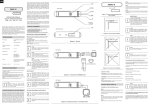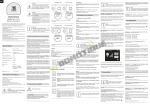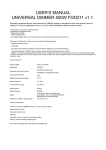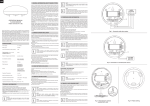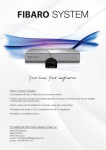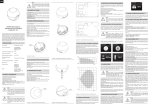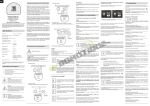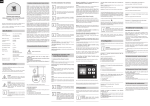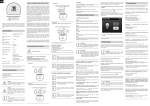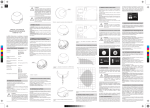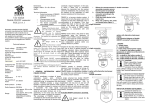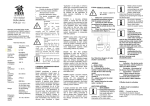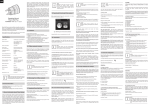Download Fibaro FGD211
Transcript
ENG DANGER Danger of electrocution. Even when the device is turned off, voltage may be present at its terminals. Any works introducing changes into the configuration of connections or the load must be always performed with disconnected voltage (disable the fuse). Connect only in accordance with the diagram presented in the manual. Incorrect connection may cause risk to health, life or material damage. Remotely controlled Dimmer of Fibaro System is designed to operate with or without neutral lead. It may be used as a switch in systems without neutral lead. Moreover, as an electronic switch it may work with: - compact fluorescent lamps - LED bulbs - fluorescent lamps with electronic stabilisers and majority of conventional stabilisers - when used with FGB001 it may operate with any dimmable load up to 500W *for loads other than resistive do not exceed 1.5A current Specifications Power supply 110-240V ±10% 50/60Hz Output Power 25-500 W (for resistive loads - 230V) 10-250W (for resistive loads - 110V) In accordance with EU standards LVD 2006/95/WE EMC 2004/108/EC R&TTE 1999/5/WE Overcurrent protection 2.5 A Circuit temperature limits 105 °C Operational temperature 10 - 40 °C For installation in boxes Ø ≥ 50mm Radio signal power: 1mW Radio protocol Z-Wave Radio Frequency 868,4 MHz EU; 908,4 MHz US; 921,4 MHz ANZ; 869,2 MHz RU; up to 50 m outdoors up to 30 m indoors (depending on building materials) Range Dimensions (L x W x H) 42 x 37 x 17 mm Electricity consumption < 0,8W Technical Information • Controlled by FIBARO system devices or any other Z-Wave controller. • Microprocessor control • Executive element: triac. • Soft start. • May operate in 3-way systems • Memory of the last lighting level settings • The device may be operated by momentary and toggle push-buttons. DANGER Danger of electrocution! All works on the device may be performed only by a qualified and licensed electrician. Observe national regulations. i ! ! TIPS • Do not connect the Dimmer to loads greater than those recommended (see technical specifications). double switch L N WARNING Applied load and the Dimmer itself may be damaged if the values of applied load are inconsistent with the technical specifications (see Specifications). The Dimmer during its operation requires the minimum load of 25 VA (or when using FGB001 device - 0.5 VA) - do not connect the power supply without a load. Only lighting devices may be connected to the Dimmer. OPERATING MANUAL UNIVERSAL DIMMER 500W FGD-211-EN-A-v1.03 As the Dimmer it operates under the following loads: - conventional incandescent - halogen 230V - low voltage halogen 12V (with electronic transformers) - dimmable LED - when used with FGB001 it may operate with any dimmable load up to 500W single switch L N DIMMER DIMMER B B Fig.1 Wiring diagram for connecting the Dimmer - 2-wire connection single switch double switch L N L N O Sx S2 S1 DIMMER B B Fig.2 Wiring diagram for connecting the Dimmer - 3-wire connection L N • EXCLUSION (Removing) - removing a device from the Fibaro radio system - Turning the light on / off: shortly press push-button no. 1. The Dimmer will be activated always at the previously set brightness. • ASSOCIATION - controlling other devices of Fibaro system - Turning the light to 100%: fast double-click push-button no. 1 (re-position twice the switch up or down). The Dimmer will switch the light at 100% L N O Sx S2 S1 DIMMER B Fig.3 Wiring diagram for connecting the Bypass NOTES FOR THE DIAGRAM: L - terminal for live lead N - terminal for neutral lead O - output terminal of the Dimmer (controlling connected lighting device, or other load) Sx - terminal for power supply to the switch connected to the Dimmer; S2 - terminal for key No. 2 S1 - terminal for key No. 1 (it has the option of entering the device in learning mode) B- service button (used to add or remove a device from the system) i STEP 1 Connect the device in accordance with the wiring diagram presented in Fig. 1. or Fig. 2. Switch on the mains voltage of 110 - 240V. [Adding/ Removing] the Dimmer [to/ from] Z-wave network STEP 2 The Dimmer must be placed within the range of Home Center controller, as adding mode requires direct communication with the controller. STEP 3 Identify key no. 1. which turns on the light (see NOTE II for toogle switch) STEP 5 The Dimmer enters the mode of inclusion/exclusion after a quick pressing three times the push-button connected to S1 terminal or push-button B located inside the housing. For toggle switch perform 3 position changes. Note! The length of wires used to connect the control switch should not exceed 20m. For supplying power to the switch, the terminal marked with "L" may be also used; Controlling a phase other than "L" is also acceptable. TIPS FOR ARRANGING THE ANTENNA: 1. Before installation ensure that the voltage supply is disconnected. 2. Connect the Dimmer according to the diagram below. 3. Place all elements in the switch box. 4. Arrange the antenna (tips are presented below diagrams of fig. 1 and 2) Toggle switch (operates as a two-position switch, it has no spring that would set one position of the switch) STEP 4 Set the Home Center controller in add/remove mode (see the controller's manual) BYPASS II Assembling the Dimmer Danger of electrocution. • INCLUSION (Adding) - a device sends "Node Info" frame, to enable user to add it to Fibaro system (Home Center) 1. Installing the Dimmer DIMMER i Locate the antenna as far from metal elements as possible (connecting wires, bracket rings, etc.) in order to prevent interferences. i Metal surfaces in the direct vicinity of the antenna (e.g. flush mounted metal boxes, metal door frames) may impair signal reception! i NOTE When one of the buttons is held down to achieve smooth change of light intensity, the second button does not respond to any action. i WARNING! The Dimmer cancels the "learning" mode after key no. 1 is pressed once. Therefore, pressing key no. 1 four times will not add the devices to the network. i WARNING! The Dimmer is set by default to operate with momentary switches (i.e. single-pole switch or bell switch). While adding the Dimmer to the network with toggle switches, ensure that all switch contacts are open (off), because closing them results in activating the push-button and this will prevent adding the device to the network. For toggle switches, it is recommended to enter the device into the inclusion/exclusion mode by using service push-button B. STEP 6 The controller indicates that the device is correctly added to the network, (see the manual of Home Center controller). 2. Resetting the Dimmer The Dimmer provides three methods for resetting. Method I : Reset by the procedure of removing the Dimmer from the existing Z-Wave network. It is carried out using the controller which has the option for adding/removing devices to/from Z-Wave network (see the manual of the Home Center controller). The controller does not have to be a part of the network into which the removed device is included. i The Dimmer enables user to control up to 5 normal devices, and 5 MultiChannel devices in group no. 1 and no. 2, group no. 3 has only one field. The first field in each group is reserved for the network controller. To add an association (using the Home Center controller), go to - Turning the light off completely (100%): fast double-click push-button no. 1. The Dimmer will set the load at 100% and the value set previously will be reset. III Activating the Dimmer L N O Sx S2 S1 i NOTE When the key is held down, the Dimmer will always reach the extreme value of 1% or 100%. DICTIONARY: • MultiChannelAssociation - controlling other multichannel devices of Fibaro system L N I GENERAL INFORMATION ABOUT FIBARO SYSTEM Fibaro is a wireless system, based on Z-Wave technology. Fibaro provides many advantages when compared to similar systems. In general, radio systems create a direct connection between the receiver and transmitter. But the radio signal is weakened by various obstacles located on its path (apartment walls, furniture, etc.) and in extreme cases it fails to transfer required data. The advantage of Fibaro System is that its devices apart from being transmitters and receivers of signals, they are also a signal "duplicators". When a direct connection path between the transmitter and the receiver can not be established, the connection may be achieved through other intermediate devices. Fibaro is a bi-directional wireless system. It means that the signal is not only sent to the receivers but also the receivers send the confirmation of its reception. This operation confirms their status so to check whether they are active. Safety of the Fibaro System transmission is comparable to the safety of transmission in data bus wired systems. Fibaro operates in the free band for data transmission. The frequency depends on radio regulations in individual country . Each Fibaro network has its own unique network identification number (home ID), which is why it is possible to co-operate two or more independent systems in a single building without any interference. Although Z-Wave is quite new technology, it has already become recognizable and officially binding standard, similarly to Wi-Fi. Many manufacturers in various industries offer solutions based on Z-Wave technology, guaranteeing their compatibility. This means that the system is open and it may be extended in the future. Find more information at www.fibaro.com. Fibaro generates a dynamic network structure. After Fibaro System is switched on, the location of its individual components is automatically updated in real-time through status confirmation signals received from devices operating in a "mesh" network. The In-wall Universal Dimmer is hereinafter referred to as Dimmer. It is designed to turn on and dim lamps (see specificatios) using radio waves, controllers and push buttons directly connected to Dimmer. Dimmer automaticly recognizes connected load, is protected from overcurrent and short circut, works noiselessly and has soft start function which allows soft brightening of connected load (in case of fluorescent lamps and other specific lamps i.e. with starter or some transformers of old type, it is possible only to turn on/off without possibility of dimmivng i NOTE It should be noted that the push-button connected to S1 terminal is a master push-button, it activates the basic functionality of the Dimmer (turning the light on/off, dimming) and starts the learning mode (Include / Exclude). The push-button connected to S2 terminal is an optional push-button and pushing it without changing the configuration parameters will not affect the status of the device. L N O Sx S2 S1 L N O Sx S2 S1 WARNING When using Fibaro Dimmer with an electronic transformers it is not recomended to connect more than one transformer with one dimmer output. WARNING Electronic transformers can produce significant noises in electrical networks which can cause Fibaro Dimmer's malfunction. It is recomended to minimize number of the electronic transformers in particular circuit. If additional information is required please contact the manufacturer of the transformer. i Do not cut or shorten the antenna - its length is perfectly matched to the band in which the system operates NOTE Push-button no. 2 may be assigned with controlling other devices (see ASSOCIATION) device options by clicking the following icon: Select the "device options" tab. Then specify to which group and what devices are to be associated. Sending relevant information to devices added to associated groups may take even a few minutes. i NOTE When the device sends control commands and the push-button is pressed again, then the current one command transmission is interrupted to send new commands. FGD211 Dimmer supports the operation of multi-channel devices. Multichannel devices are devices that include two or more circuits inside one physical unit. V Configuration The following settings are available in the Fibaro interface as simple options that may be chosen by selecting the appropriate box. In order to configure the Dimmer (using Fibaro controller), go to device options by clicking the following icon: Select the "device options" tab. 4. Controlling the Dimmer using a command: ALL ON / ALL OFF The Dimmer responds to commands ALL ON / ALL OFF that may be sent by the Home Center controller or by other controller belonging to the system. ALL ON / ALL OFF commands are usually implemented in the remote controls using Z-wave protocol, and they are used to issue commands directed to the entire system. By default, both commands ALL ON and ALL OFF are accepted. Settings may be changed by entering an appropriate value into configuration register no. 1 (see configuration register) In this way the user may determine to which commands the device should respond. 5. Controlling the Dimmer by the main controller of the Fibaro system (Home Center) After adding the Dimmer to the network, it will be represented in the Fibaro controller by the following icon: Parameter No. 1 - Activate / deactivate functions ALL ON / ALL OFF. Default value: 255 Available configuration parameters: 255 - ALL ON active, ALL OFF active. 0 - ALL ON is not active ALL OFF is not active 1 - ALL ON is not active ALL OFF active 2 - ALL ON active ALL OFF is not active Parameter No. 6 - Sending commands to control assigned to 1-st association group (key no. 1). Default value: 0 devices Available configuration parameters: 0 - commands are sent when device is turned on and off 1 - commands are sent when device is turned off. Enabling device does not send control commands. Double-clicking key sends 'turn on' command, dimmers memorize the last saved state (e.g. 50% brightness). 2 - commands are sent when device is turned off. Enabling device does not send control commands. Double-clicking key sends 'turn on' command and dimmers are set to 100% brightness. NOTE: Parameter 15 value must be set to 1 to work properly. This activates the double-click functionality - dimmer/roller shutter control. Fig. 4 Dimmer icon shown by the Home Center controller Dimming / brightening is performed by moving the slider. The current status of the Dimmer is indicated on the bar indicator. turning the device ON / OFF - ON and OFF icons are used for complete dimming / brightening IV Association The association enables the Dimmer to control directly a device included in Z-Wave network e.g. other Dimmer, Relay Switch or Roller Shutter. Parameter No. 7 – Checking the device status before sending a control frame from the key no. 2. Default value: 1 Available configuration parameters: 0 - Device status is not checked. 1 - Device status is checked. Info: Key no. 2 is not represented by any physical device expect of devices on association list. This functionality prevents of lack of reaction on pressing key no. 2 through polling devices from list one by one and checking thier actual states. It is not possible to check the device status before sending a control frame from the key no. 2 if roller blind switch is chosen in parameter 14 (value 2) If devices state is checked before sending asociation then parameter 19 should be set to value 0. i NOTE The association allows the system to transfer direct control commands between devices, the main controller does not take part in such communication. Parameter No. 8 – The percentage of a dimming step at automatic control. Default value: 1 Options for changing parameter 1-99 Method II : Reset by holding B button for 3 sec. after connecting mains voltage to the Dimmer The Dimmer provides the association of three groups. 3. Controlling the Dimmer by a switch. 1st group is assigned to key no. 1 Parameter No. 9 - Time of manually moving the Dimmer between the extreme dimming values. Default value: 5 2nd group is assigned to key no. 2 Options for changing parameter 1-255 (10ms – 2.5s) Momentary switch (after releasing the push-button a spring automatically pushes back and disconnects the button) Turning the light on / off: change the position of push-button no. 1. The Dimmer will be activated always at the previously set brightness. Brightening/ dimming the light: hold key no. 1 down. 3rd group for controllers such Home Center for state reporting Parameter No. 10 - Time of Automatic moving the Dimmer between the extreme dimming values. Default value: 1 Options for changing parameter 0-255 (0ms – 2.5s) 0 - this value disables the smooth change in light intensity NOTE value 0 is required for inductive and capacitive devices unsuitable for dimming, (e.g. fluorescent lamps , motors etc.) Parameter No. 11 - The percentage of a dimming step at manual control. Default value: 1 Options for changing parameter 1-99 Parameter No. 12 - Maximum Dimmer level control. Default value: 99 Parameter No. 18 - The function of synchronizing the light level for associated devices. The Dimmer communicates the position to the associated device. Default value: 0 Options for changing parameter 0-1 0 - function disabled 1 - function enabled Parameter No. 19 - Assigns bistable key status to the device status. Default value: 0 Available configuration parameters: 0 - [On / Off] device changes status on key status change. 1 - Device status depends on key status: ON when the key is ON, OFF when the key is OFF. Options for changing parameter 2-99 Info: Remote control from Fibaro System Is Still Possible. This function is useful When you want display status of external devices, e.g. Motion Sensor, in Fibaro System. Parameter No. 13 - Minimum Dimmer level control Default value: 2 Parameter No. 30 - Alarm of any type (general alarm, water flooding alarm, smoke alarm: CO, CO2, temperature alarm). Default value: 3 ALARM FLASHING Options for changing parameter 1-98 100% 100% max 70 0 - DEACTIVATION - the device does not respond to alarm data frames 1 - ALARM DIMMER ON - the device turns on after detecting an alarm 2 - ALARM DIMMER OFF - the device turns off after detecting an alarm 3 - ALARM FLASHING the device periodically changes its status to the opposite, when it detects an alarm within 10 min. Parameter No. 39 - Active flashing alarm time. Default value: 600 min 20 0% Input S2: holding down ID 22 releasing ID 23 double click ID 24 (depends on parameters 15 value - 1 = double click active) triple click ID 25 If parameter no.19 set to 0 (default), then one click ID 26 is sent If parameter no.19 is set to 1 following IDs are sent: switch from “off” to “on” ID 20 switch from “on” to “off” ID 21 Roller blind switch (parameter 14 set to 2): Input S1, Turning on the light: switch from “off” to “on” ID 10 double click ID 14 (depends of parameter 15 value 1 - double click functionality) triple click ID 15 brighten ID 17 releasing ID 13 Input S2, Turning off the light: switch from “on” to “off” ID 11 triple click ID 25 dim ID 18 releasing ID 13 ADVANCED FUNCTION Parameter No. 20 - The function enabling the change of control impulse length. Default values: 110 for 50Hz or 101 for 60Hz Options for changing parameter 101-170 This function will enable decreasing the minimum level of the Dimmer by extending the control impulse. By changing the minimum level, the user may completely dim LED bulbs. Not all LED bulbs available on the market have the dimming option. Available configuration parameters: [1-65535][ms] 0% real scale scale available to the user NOTE: The maximum level may not be lower than the minimum level. Recommended values of parameters 12 and 13 (max and min level) for controlling the devices are as follows: • AC motors [min 60%, max 99%] • fluorescent lamps, fluorescent tubes, LED [min 98%, max 99%] [parameter 10 set to 0] Parameter No. 14 - Switch type. Choose between momentary switch and toggle switch. Default value: 0 Available setings: 0 – momentary switch 1 – toggle switch 2 - Roller blind switch (UP / DOWN) - two switch keys operate the Dimmer Parameter No. 15 – Double click option (set lightning at 100%). Default value: 1 Available configuration parameters: 0 Double click disabled 1 Double click enabled Parameter No. 16 - Saving the state of the device after a power failure. The Dimmer will return to the last position before power failure. Default value: 1 Parameter No 40 - Updating the dimming level without the input from the switch. Available settings: from 1 to 99 Parameter’s value changes depending on the dimming level. Parameter No. 41 - Scene activation functionality. Default value: 0 Possible parameter settings: 0 – functionality deactivated 1 – functionality activated The device offers the possibility of sending commands compatible with Command class scene activation. Information is sent to devices assigned to association group no. 3. Controllers such as Home Center 2 are able to interpret such commands and based on these commands they activate scenes, to which specific scene IDs have been assigned. The user may expand the functionality of the button connected to inputs S1 and S2 by distinguishing the actions of keys connected to those inputs. For example: double click would activate the scene “goodnight” and triple click would activate the scene “morning”. Scene ID is determined as follows: Momentary switch (parameter 14 set to 0): Input S1: holding down ID 12 (option inactive in case of roller blind switch) releasing ID 13 double click ID 14 (depends on parameters 15 value - 1 = double click active) triple click ID 15 one click ID 16 Input S2: holding down ID 22 (option inactive in case of roller blind switch) releasing ID 23 double click ID 24 (depends on parameters 15 value - 1 = double click active) option inactive in case of roller blind switch triple click ID 25 one click ID 26 Options for changing parameter: Toggle switch (parameter 14 set to 1): 0 - the Dimmer does not save the state after a power failure, it returns to "off" position 1 - the Dimmer saves its state before power failure Input S1: holding down ID 12 releasing ID 13 double click ID 14 (depends on parameters 15 value - 1 = double click active) triple click ID 15 If parameter no. 19 is set to 0: single click ID16 is sent Parameter No. 17 - The function of 3 - way switch, provides the option to double key no. 1. The Dimmer may control two toggle push-buttons or an infinite number of momentary push-buttons. Default value: 0 If parameter no. 19 is set to 1 following IDs are sent: switch from “off” to “on” ID 10 switch from “on” to “off” ID 11 ∆t 101 110 170 WARNING! Wrong setting of the function may cause incorrect operation of the Dimmer. VI Additional Functionality Operating alarm data frames Fibaro system allows user to set response of devices to alarm situations (response to data-frames ALARM_REPORT and SENSOR_ALARM_REPORT) Fibaro Dimmer responds to the following types of alarms: • General Purpose Alarm - GENERAL PURPOSE ALARM [0x00] • Smoke Alarm - ALARM CO2 [0x02], ALARM CO [0x01], ALARM SMOKE [0x03] • Water Flooding Alarm - ALARM WATER [0x05] • Temperature Alarm - ALARM HEAT [0x04] Alarm data-frames are sent by devices that are system sensors (e.g., flood sensors, smoke detectors, motion detectors, etc.). The device may respond in the following manner to received data-frames (settings are configured in configuration parameters, see section V Configuration ): • 0 - DEACTIVATION - the device does not respond to alarm data frames • 1 - ALARM ON - the device turns on after detecting an alarm • 2 - ALARM OFF - the device turns off after detecting an alarm • 3 - ALARM FLASHING - the device periodically changes its status to the opposite when it detects an alarm (lights on/off alternately) VII Operating the Dimmer The Dimmer may be operated using the following control elements: − any controller compatible with the system (e.g. Home Center controller) − a mobile phone (e.g. iPhone and phones from other manufacturers with appropriate software) − tablet (such as iPad) − PC, using a web browser − push-buttons connected to inputs S1 and S2 − service button B, located inside the housing (activates learn mode) VIII Procedures for malfunctions Options for changing parameter 0-1 The device does not respond to a pre-programmed transmitter: 0 - the function of 3-way switch is disabled 1 - the function of 3-way switch is enabled • Make sure that the maximum range is not exceeded and the signal path is not obstructed by metal surfaces such as metal cabinets, etc. • Make sure the device is not in the programming mode, or repeat the programming process. IX GUARANTEE 1. The Guarantee is provided by FIBAR GROUP Sp. z o.o. (hereinafter "Manufacturer"), based in Poznan, ul. Lotnicza 1; 60-421 Poznan, entered in the register of the National Court Register kept by the District Court in Poznań, VIII Economic Department of the National Court Register, no. 370151, NIP 7811858097, REGON: 301595664. 2. The Manufacturer is responsible for equipment malfunction resulting from physical defects (manufacturing or material) of the Device for 12 months from the date of its purchasing. 3. During the Guarantee period, the Manufacturer shall remove any defects, free of charge, by repairing or replacing (at the sole discretion of the Manufacturer) any defective components of the Device with new or regenerated components, that are free of defects. When the repair impossible, the Manufacturer reserves the right to replace the device with a new or regenerated one, which shall be free of any defects and its condition shall not be worse than the original device owned by the Customer. 4. In special cases, when the device cannot be replaced with the device of the same type (e.g. the device is no longer available in the commercial offer), the Manufacturer may replace it with a different device having technical parameters similar to the faulty one. Such activity shall be considered as fulfilling the obligations of the Manufacturer. The Manufacturer shall not refund money paid for the device. 5. The holder of a valid guarantee shall submit a guarantee claim through the guarantee service. Remember: before you submit a guarantee claim, contact our technical support using telephone or e-mail. More than 50% of operational problems is resolved remotely, saving time and money spent to initiating guarantee procedure. If remote support is insufficient, the Customer shall fill the guarantee claim form (using our website - www.fibargroup.com) in order to obtain claim authorization. When the guarantee claim form is submitted correctly, the Customer shall receive the claim confirmation with an unique number (Return Merchandise Authorization -RMA). 6. The claim may be also submitted by telephone. In this case, the call is recorded and the Customer shall be informed about it by a consultant before submitting the claim. Immediately after submitting the claim, the consultant shall provide the Customer with the claim number (RMA-number). 7. When the guarantee claim form is submitted correctly, a representative of the Authorised Guarantee Service (hereinafter as "AGS") shall contact the Customer. 8. Defects revealed within the guarantee period shall be removed not later than 30 days from the date of delivering the Device to AGS. The guarantee period shall be extended by the time in which the Device was kept by AGS. 9. The faulty device shall be provided by the Customer with complete standard equipment and documents proving its purchase. 10. Parts replaced under the guarantee are the property of the Manufacturer. The guarantee for all parts replaced in the guarantee process shall be equal to the guarantee period of the original device. The guarantee period of the replaced part shall not be extended. 11. Costs of delivering the faulty device shall be borne by the Customer. For unjustified service calls, the Service may charge the Customer with travel expenses and handling costs related to the case. 12. AGS shall not accept a complaint claim only when: • the Device was misused or the manual was not observed, • the Device was provided by the Customer incomplete, without accessories or nameplate, • it was determined that the fault was caused by other reasons than a material or manufacturing defect of the Device • the guarantee document is not valid there is no proof of purchase, 13. The Manufacturer shall not be liable for damages to property caused by defective device. The Manufacturer shall not be liable for indirect, incidental, special, consequential or punitive damages, or for any damages, including, inter alia, loss of profits, savings, data, loss of benefits, claims by third parties and any property damage or personal injuries arising from or related to the use of the Device. 14. The guarantee shall not cover: • mechanical damages (cracks, fractures, cuts, abrasions, physical deformations caused by impact, falling or dropping the device or other object, improper use or not observing the operating manual); • damages resulting from external causes, e.g.: flood, storm, fire, lightning, natural disasters, earthquakes, war, civil disturbance, force majeure, unforeseen accidents, theft, water damage, liquid leakage, battery spill, weather conditions, sunlight, sand, moisture, high or low temperature, air pollution; • damages caused by malfunctioning software, attack of a computer virus, or by failure to update the software as recommended by the Manufacturer; • damages resulting from: surges in the power and/or telecommunication network, improper connection to the grid in a manner inconsistent with the operating manual, or from connecting other devices not recommended by the Manufacturer. • damages caused by operating or storing the device in extremely adverse conditions, i.e. high humidity, dust, too low (freezing) or too high ambient temperature. Detailed permissible conditions for operating the Device are defined in the operating manual; • damages caused by using accessories not recommended by the Manufacturer • damages caused by faulty electrical installation of the Customer, including the use of incorrect fuses; • damages caused by Customer's failure to provide maintenance and servicing activities defined in the operating manual; • damages resulting from the use of spurious spare parts or accessories improper for given model, repairing and introducing alterations by unauthorized persons; • defects caused by operating faulty Device or accessories. 15. The scope of the guarantee repairs shall not include periodic maintenance and inspections, in particular cleaning, adjustments, operational checks, correction of errors or parameter programming and other activities that should be performed by the user (Buyer). The guarantee shall not cover natural wear and tear of the Device and its components listed in the operating manual and in technical documentation as such elements have a defined operational life. 16. If a defect is not covered by the guarantee, the Manufacturer reserves the right to remove such defect at its sole discretion, repairing the damaged or destroyed parts or providing components necessary for repair or replacement. 17. This guarantee shall not exclude, limit or suspend the Customer rights when the provided product is inconsistent with the purchase agreement. i This Device may be used with all devices certified with Z-Wave certificate and should be compatible with such devices produced by other manufacturers. Any device compatible with Z-Wave may be added to Fibaro system. FIBARGROUP FIBARO In case of any technical questions contact customer service centre in your country. www.fibargroup.com


